Arts & Entertainment Community
Day Tripper | Mermaids, the sea, and a tree
I live I the Pacific Northwest for a reason. Well, truthfully, for many reasons, but one of the primary reasons I love Western Washington is because I really dislike hot weather. So, on a recent weekday, when all the weather prognosticators were predicting temperatures approaching the century mark, I decided to escape for a day.
Arts & Entertainment Sponsor
Arts & Entertainment stories are made possible in part by the Gig Harbor Film Festival, a proud sponsor of Gig Harbor Now.
One of my teen granddaughters, who had been hoping for a break from Spokane’s even warmer weather, was visiting. She was more than happy to join me, so we fled Gig Harbor and headed to the ocean for the day.
We were excited to learn that we have an internationally acclaimed (that may be a stretch, but bear with me) museum nearby. The International Mermaid Museum is only 89 miles away in the seaside village of Aberdeen. It did occur to us that it’s possible that it’s the only mermaid museum in the world, but whatever.
I was also a bit concerned that my teen companion was too cool to get very excited about mermaids. I did recall a visit to Washington D.C. with her aunt. There, surrounded by an array of the finest museums in the world, the place she chose for us to spend a day was the International Spy Museum. And we loved every minute of it. I could only hope that our visit with the mermaids of the world would turn out half as well.
Getting there
In preparation for our road trip, we sat down with a map. We quickly decided that there are several ways to get to Aberdeen. One is all highways and freeways. The other, the backway, consists, for the most part, of two-lane rural roads. Since both routes are just a skootch under 90 miles, we decided to make our trip a loop.
Going west, we headed out Highway 302 to Highway 3, and down through Shelton. Once at Shelton, there are a variety of options. The easiest is to stay on 3 until it intersects with Highway 101 at Shelton. From there 101 South runs into Highway 108 at Kamiche. Highway 108 terminates at Highway 8 in McCleary and from there, it’s a straight shot into Aberdeen. Coming home, we took Highway 12 east out of Aberdeen until it became Highway 8 and then stayed on 8 until it transitioned to Highway 101. At the junction with the freeway, merge onto I-5 north and head home.
All roads lead to Aberdeen
If you’re going to Aberdeen, you may as well also check out Hoquiam. And there’s lots to check out in Hoquiam as well. It’s worth noting that many small towns in Western Washington have sites on the National Registry of Historic Places. And most of them have at least one (and often many more) small museums. There are actually a lot of places to investigate in the greater Grays Harbor area that includes Hoquiam, Aberdeen, Westport and Ocean Shores.
While doing our research we came across a guide to Grays Harbor museums. Having already chosen the International Mermaid Museum as our primary destination, we decided that we would pick one more museum to investigate, and if possible, that it would also be on the National Historic Registry. We chose the Polson Museum in Hoquiam.
While we really enjoyed our time there, and recommend it highly, we want you to be able to make your own choices. Here’s the link to the guide that we used. The brochure includes brief descriptions of the museums including hours and entry fees.
The Polson Museum
The Polson Museum is located at 1611 Riverside Ave. in Hoquiam. Recently restored, it’s a 1924 colonial revival that was once owned by Arnold and Priscilla Polson. The grounds include a rose garden, railroad camp, the 1906 Polson 45 Baldwin locomotive and a barnful of machinery. The museum is open from 11 a.m. to 4 p.m. Wednesday through Saturday and from noon to 4 p.m. Sunday. Admission is $5 for adults, $3 for students, and under 6 is free.
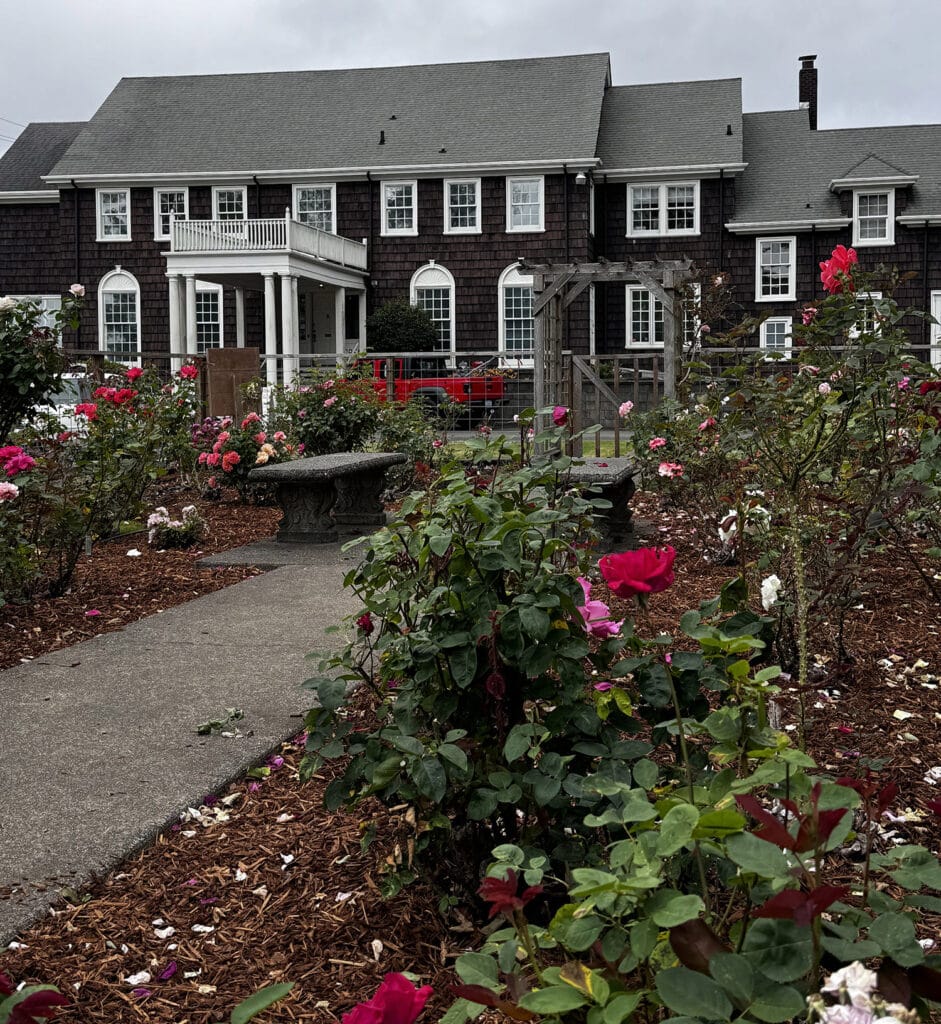
The Polson Mansion. Photo by Mary Williams
Alexander and Robert Polson migrated from Nova Scotia in the late 1800s. In 1903, they founded the Polson Logging Company. Alexander served as president while Robert was the manager. Alexander became a leader in the city of Hoquiam and was elected to the state Senate, where he served for many years. They were heavily involved in the logging industry, starting pulp, paper and plywood mills.
The Polson home was built in 1924 as a wedding present to Arnold Polson from his Uncle Robert. The mansion was designed with 26 rooms, including six bathrooms, and four fireplaces. The Polsons moved to Seattle in 1965, where Arnold died in 1968. Arnold’s widow donated the building to the city of Hoquiamin 1976.
Railroad Camp
Volunteer labor and private donations helped restore the building after the city took possession. The Railroad Camp occupies one corner of the property. It is being renovated to retain the qualities of an old locomotive shed. Eventually, it will house many artifacts from the Polson family’s extensive heavy machinery collection.
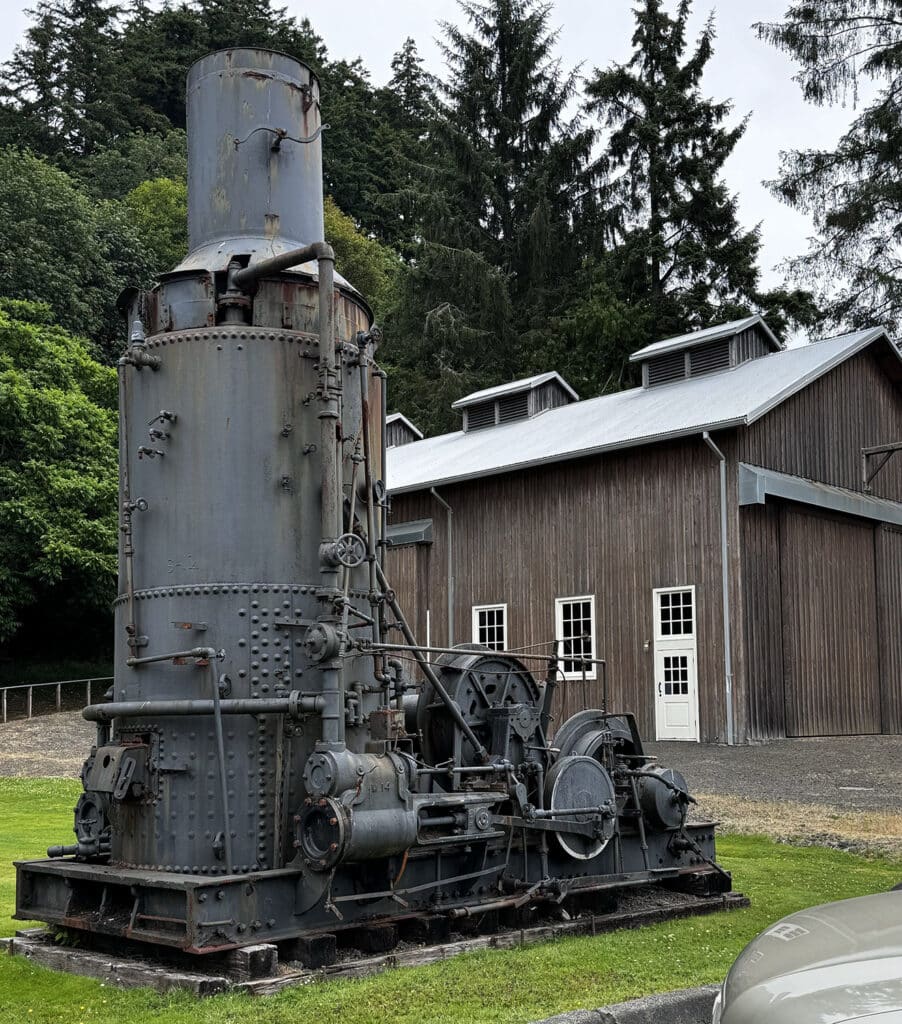
The Railroad Camp on the grounds of the Poulson Mansion. Photo by Mary Williams
In front of the mansion is the Burton Ross Memorial Rose Garden. Several other pieces of equipment are dotted around the museum grounds.
The city of Hoquiam owns and maintains the building and grounds, while the Polson Park and Museum Historical Society oversees exhibits and collections. It became a National Historic Site in June 1979.
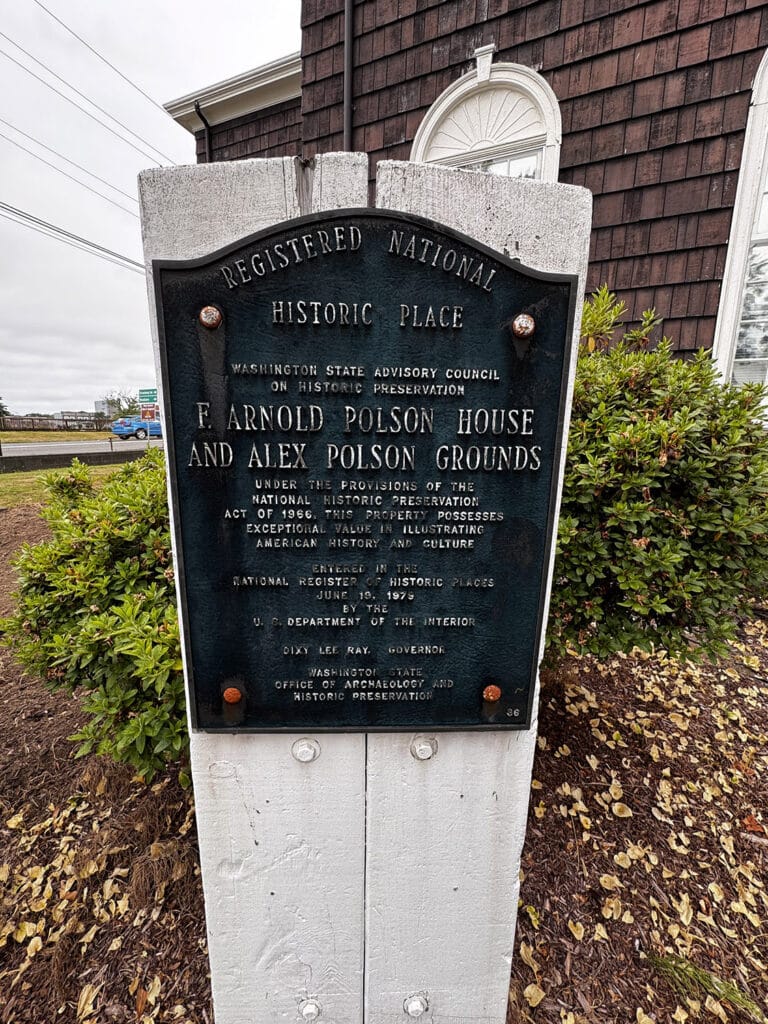
The Polson mansion and its grounds are on the National Register of Historic Places. Photo by Mary Williams
International Mermaid Museum
The International Mermaid Museum uses mermaid mythology to teach ocean ecology. Its mission is to teach ocean ecology from seashore to sea floor immersed in mermaid mythology uniting world oceanic cultures. The outside area is a corrugated metal building.
The museum is interesting in its own way. It is a common destination for school field trips and to support classroom activities in ocean ecology. I’m fairly certain my concerns about it holding the interest of a teen were well founded, but we did enjoy looking around and reading the signage.
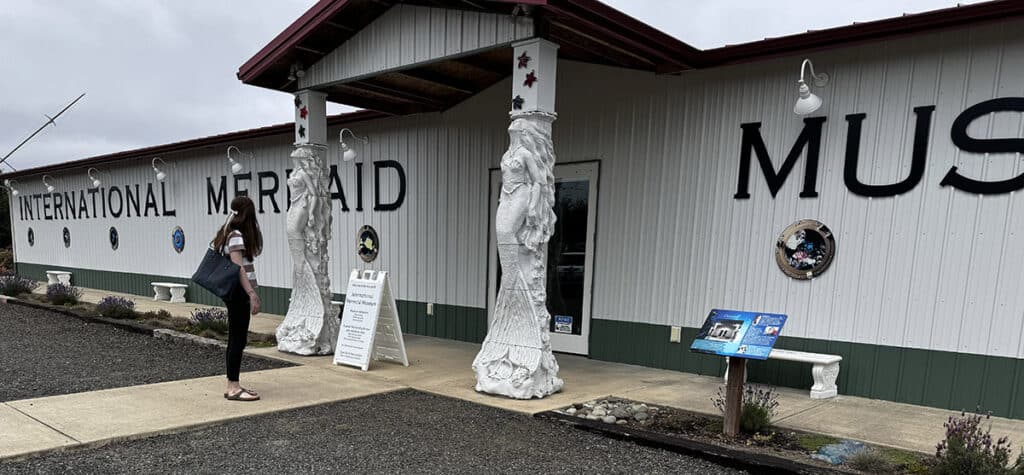
The International Mermaid Museum in Aberdeen. Photo by Mary Williams
Exhibits demonstrate the commonality of mermaid lore in all of the oceanic countries in the world. The museum uses storytelling to encourage children and adults to learn more about the undersea environment. It emphasizes the importance of clean oceans, the sea as a living environment and the importance of ocean exploration. Each area has a descriptive plaque that explains how the section relates mermaid mythology to ocean ecology.
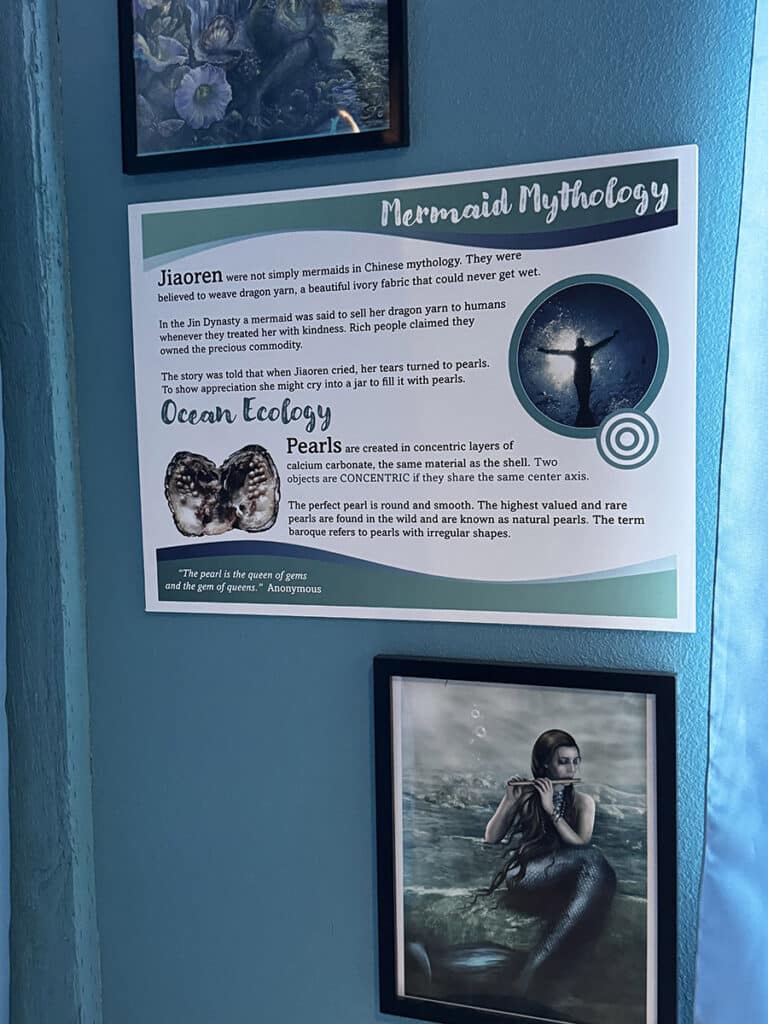
An interpretative sign at the International Mermaid Museum in Aberdeen. Photo by Mary Williams
Museum artifacts stress the importance and use of mermaids in storytelling. Movies from Splash to The Little Mermaid developed positive messages about the relationship of humans to sea creatures. Those of us who read them as kids will remember how sea creatures and mermaids played a role as far back as when the Grimms and Andersen Fairy Tales were written.
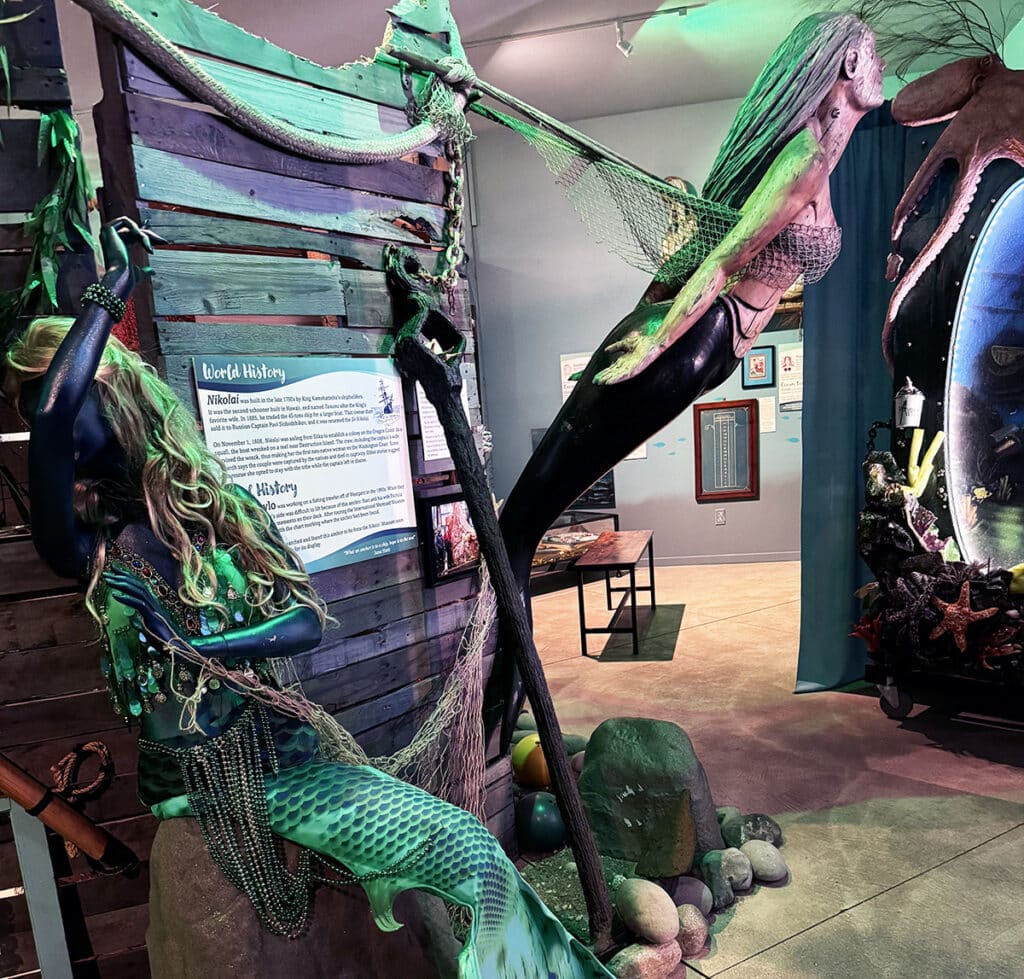
Mermaids in storytelling. Photo by Mary Williams
The museum grounds also include a gift shop, of course. A section of it also carries bigfoot and pirate merchandise.
A giant movie screen features rotating 5-minute excerpts from some of the world’s most favorite mermaid movies. A second area requires a bit more imagination as various artifacts represent a sunken ship, a fallen mast, and a tattered sailcloth. Kids will love being able to borrow a tail and mermaid apparel to pose for photos. There is even a throne for them to sit on.
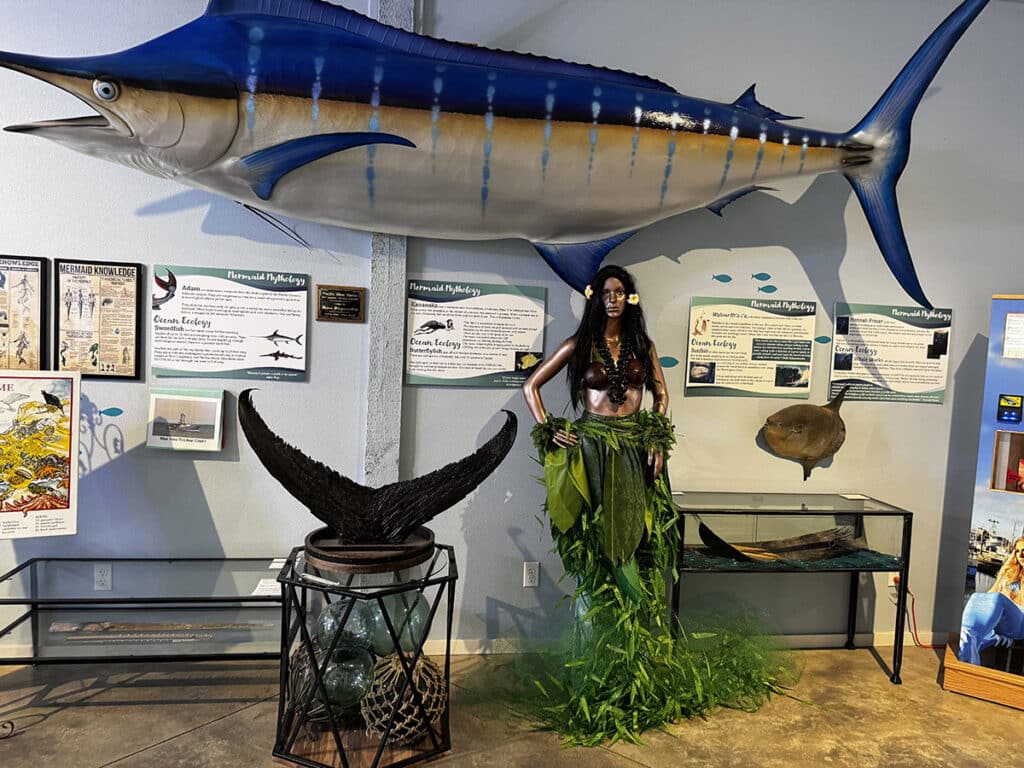
The entry at the International Mermaid Museum in Aberdeen. Photo by Mary Williams
Aberdeen’s own
The most well-known native son of Aberdeen is probably Kurt Cobain. A small park called Cobain Landing, located at the base of the Young Street Bridge, commemorates the Nirvana singer’s history in the area. Cobain claimed to have lived under the bridge during a short period of homelessness. The park includes statutes and signs erected as a tribute to Cobain, although various websites say they are now often covered with graffiti.
Cobain’s wife, Courtney Love, is reported to have kept some of his ashes in a bank vault in Los Angeles. They were finally scattered by his daughter, Frances Bean Cobain, Love, and his mother in McLane Creek in Olympia.
Grays Harbor Lighthouse
The Grays Harbor Lighthouse is located a block from Westport Light State Park. When the lighthouse is open, you can climb the tower’s 135 steep cast-iron spiral staircase. Reportedly, (I certainly can’t verify the fact) if you make it to the top on a clear day, you will find a 360-degree view of the ocean and surrounding area. Look to the east and you may even be able to see the top of Mount Rainier.
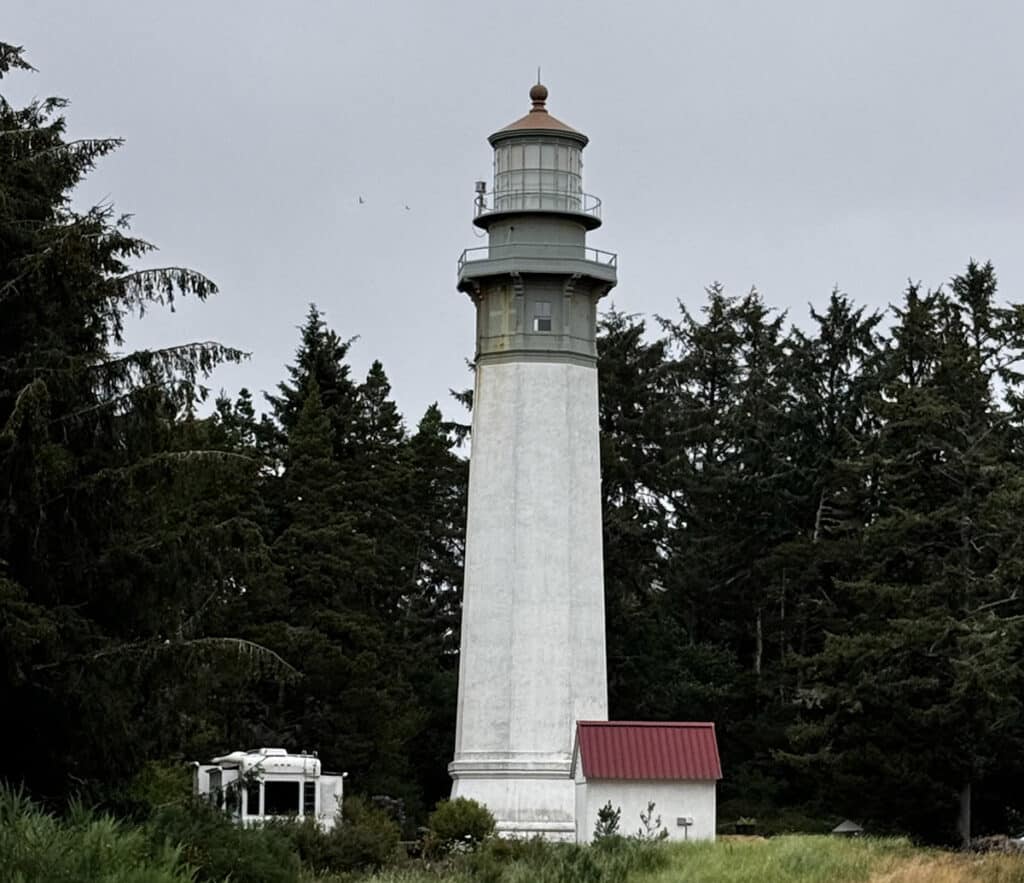
The Grays Harbor Lighthouse. Photo by Mary Williams
The 107-foot-tall lighthouse, the tallest in Washington, still contains the original clamshell-shaped Fresnel lens built in Paris in 1895. It went into service in 1898 and was automated in 1933. The building is an octagonal tower, resting on a twelve-foot-thick foundation of sandstone. The walls are made of brick with a coating of cement on the exterior. The site of the lighthouse borders Westport Light State Park.
The station was equipped with a windmill, a water tank, a well, two keeper’s dwellings, two oil houses, and a fog signal building. The keepers’ houses and the duplex used for assistants no longer stand.
The signal began operation in March 1899 and was typically in operation for about 500 hours each year. To produce the necessary steam for the signal, the windmill pumped water to the building where a coal fire converted the water to steam.
A new light
The red and white flashes of light produced by the lens could be seen up to 16 miles at sea. In 1992, the Fresnel lens was turned off. A smaller light manufactured in New Zealand went up in its place on the lantern room balcony. The new light operates on a 35-watt bulb and can be seen for more than 17 miles.
The tower was closed to the public during the 1990s because of health concerns over the mercury-filled drum that was part of the original fog signal building. In 1998 the Westport-South Beach Historical Society negotiated a lease agreement with the Coast Guard and began cleaning up the tower. Tours resumed in 2001, when the building was determined to be safe.
The lighthouse is on Point Chehalis at the southern side of the entrance to Grays Harbor. The historical society was granted ownership in 2004 under the National Historic Lighthouse Preservation Act. A circuit court decreed in a condemnation hearing that $500 would be a fair price for the property.
Westport Light State Park
Insert State Park sign picture here
Westport Light State Park is a 560-acre day use park with 1,215 feet of shoreline. The park features a marina, boat launch, and maritime history museum (Wesport Maritime Museum, 2201 Westerhaven Dr., Westport — Number 9 on your museum guide). An ADA accessible hiking trail runs along the beach. The park is open every day from 8 a.m. to 10 pm. Dogs are allowed on leash.

Westport Light State Park near Aberdeen. Photo by Mary Williams
Westport Lighthouse Trail
The Westport Lighthouse Trail is a 4.5 mile out-and-back trail. Considered an easy route, it takes about an hour and a half to complete. Some of the things you might enjoy are birding, hiking, and running. Because the trail is paved, it is stroller and wheelchair friendly.
The Tree of Life
I seem to be making a habit of this pushing the limits of thing I’ve started. But at least this month there’s a really good reason why. For years now, I’ve been hearing about the Tree of Life. It is located on the Kalaloch Lodge beach, just off the the lodge’s campground parking lot, and is really spectacular.
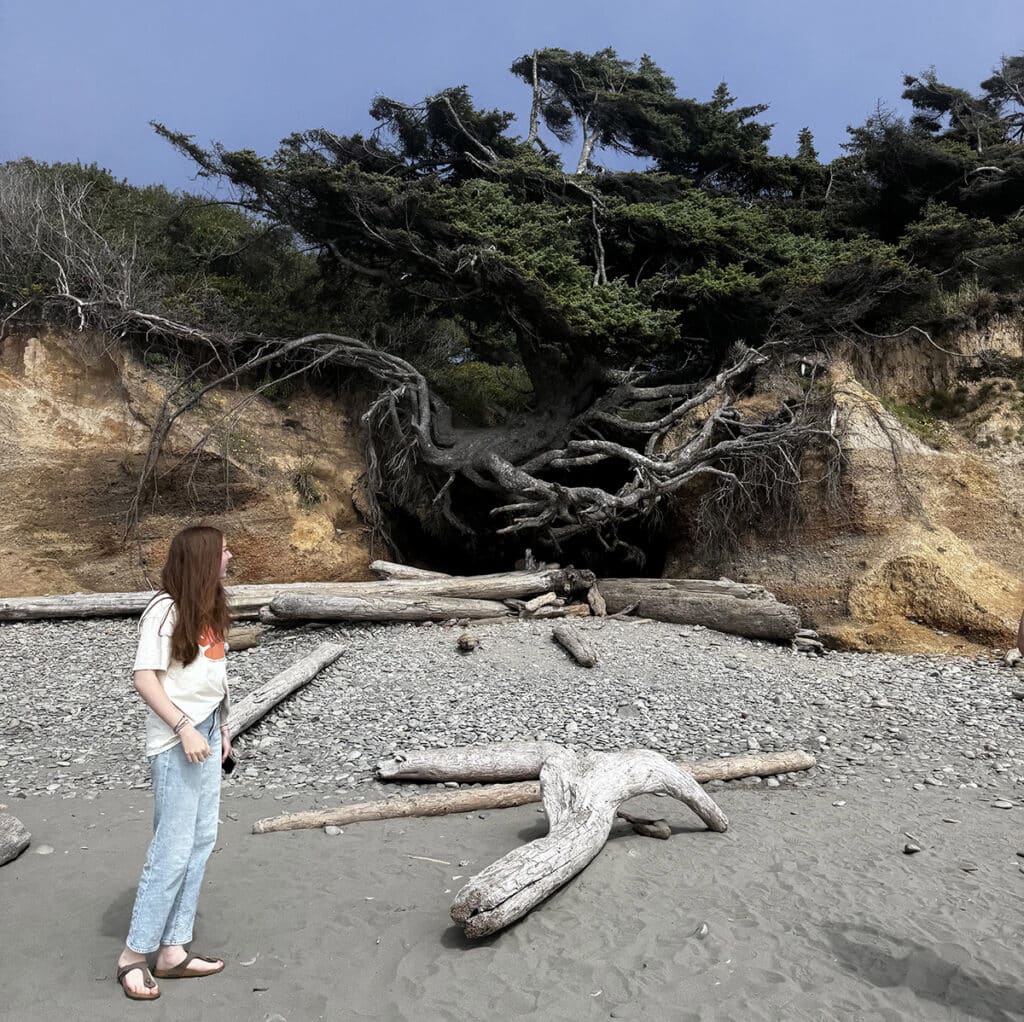
The Tree of Life near Aberdeen. Photo by Mary Williams
I’ve also heard that the tree’s days are numbered. As you can see in the picture, it is suspended between two cliffs. Stormwater erosion washed away the soil that should be needed to support it and provide it with nourishment. For probably 5 years or more, I’ve heard that it’s a matter of “see it now, or you won’t see it at all” because the next winter storm is going to take it out.
I knew I would not be happy if I was within 75 miles and didn’t go see it. Since Ellie was with me, I had extra incentive. I really wanted to afford her the opportunity of seeing it in person while it’s still here. Seeing something like that with a grandma is something you will potentially remember all of your life. So instead of heading home once we’d explored Aberdeen, we headed north instead.
It was well worth the 100-mile detour.
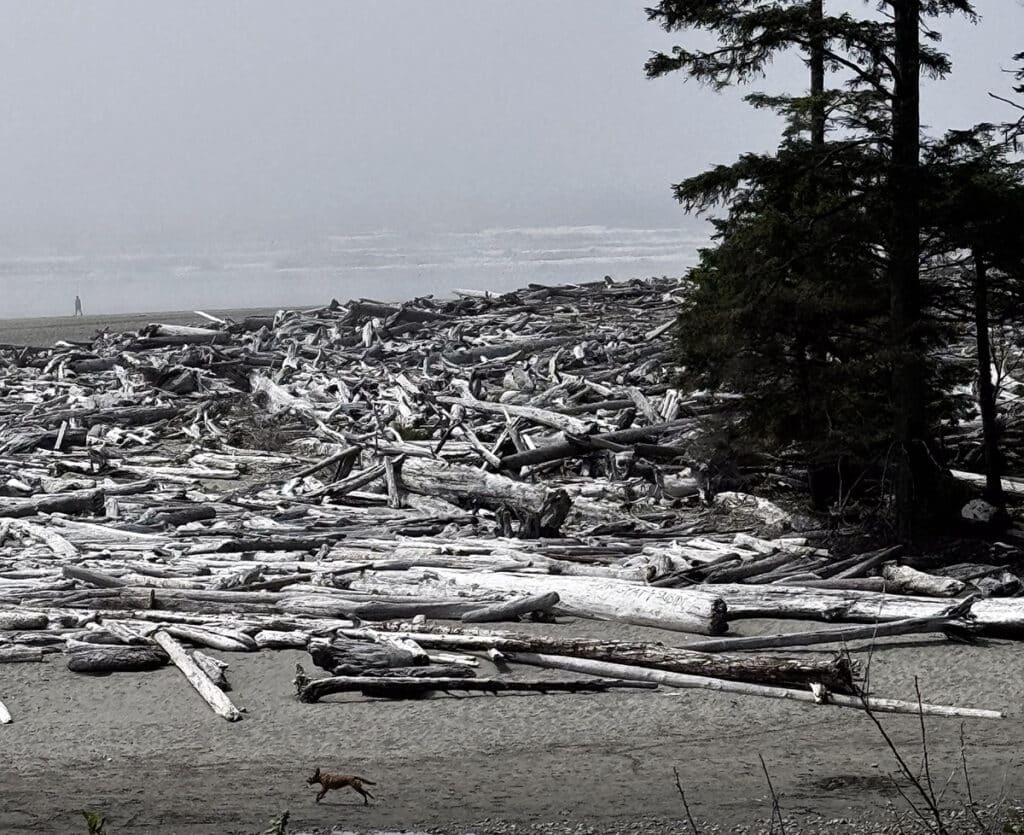
The driftwood-littered beach at Kalaloch. Photo by Mary Williams
When we first arrived at Kalaloch Lodge, we surveyed the beach below it. The display of driftwood that has washed on shore is nothing short of amazing. Access to the beach and tree are about a quarter mile further to the north. Get back on Highway 101, go to the first entrance to the Kalaloch Campground, and turn in. Take the road to the left, and park nearest to the water. Day-use parking at the campground is free.
Erosion and survival
There are two paths down to the beach. Take my word for it. They are not for the faint of heart. The path ends at a rickety stairway, and the final step is probably a good foot off the beach. To say it is not ADA accessible is an understatement.
The tree is a Sitka spruce, the largest type of spruce. It is noted for its towering height and its wide trunk. Underneath the webbed roots of the tree is the Tree Root Cave. Inside, a stream falls into the cave and flows to the ocean. The tree is located on the edge of a sandy bluff, and between two cliffs.
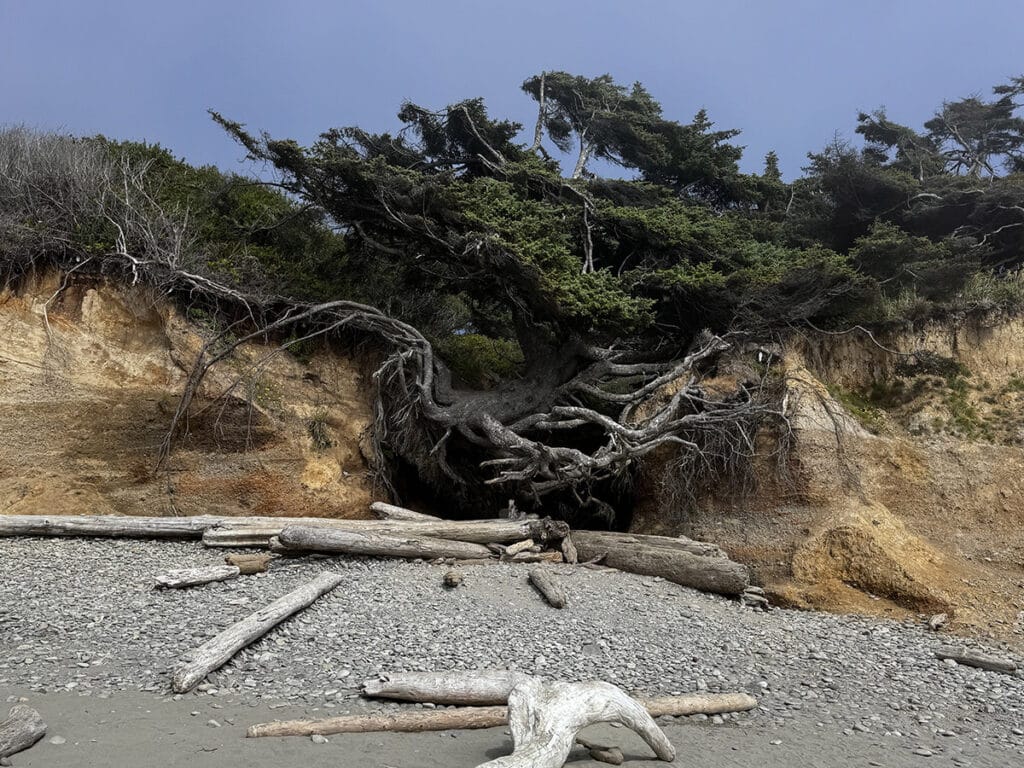
The Tree of Life near Aberdeen. Photo by Mary Williams
Over time, erosion from a small stream flowing from behind the tree and into the ocean has completely weathered away the ground beneath it. A few root tendrils cling to either side of the cliffs and manage to support the tree’s weight.
The stream adds to the annual erosion that keep the roots of the tree visible. Despite its apparent lack of support or nutrients, the tree stays green and continues to grow.
There is concern about how the tree appears to be sagging. Every website stresses that it’s a miracle that while other trees fall, the Tree of Life has withstood so many ferocious storms off the ocean. We can only hope that it continues to awe spectators for many years. We’re both really glad we made the long detour.
A note about state and national parks
It’s really hard to visit the Hoquiam/Aberdeen area and not be tempted to wander into a corner of Olympic National Park. A beautiful cool day in July still found few crowds and little traffic. Figuring out which pass you should buy or entrance fee to pay isn’t exactly straightforward. Check out the NPS website to figure it out.
Entrance is free on a few select days. They include Aug. 3, the Great American Outdoors Act anniversary; Aug. 25, the National Park Service anniversary; Sept. 28, National Public Lands Day; and Veterans Day, Nov. 11.
The state’s Discovery Pass, which allows access to and parking at state parks and recreation lands, is a little less confusing, but not confusion-free. Some areas require one, some don’t. For more information, check out discoverpass.wa.gov. An annual pass is $30, while a one-day pass is $10.
About the Day Tripper column
Gas prices are sky high, and a night in a hotel is approaching astronomically expensive. So, for the foreseeable future, I imagine many of you are going to find yourselves taking day trips rather than the road trip vacations we’ve grown to love.
This beautiful region in which we live is ripe with opportunities to explore new places, see new things, and learn a little something at the same time. I promise to keep the longest journeys to a one-way distance of under 200 miles. Whether you want to make it an overnight trip, a weekend, or just a very long day trip, we should be able to pull it off.
I hope you’ll grant me the honor of your virtual company as we travel these roads together. Happy trails!

